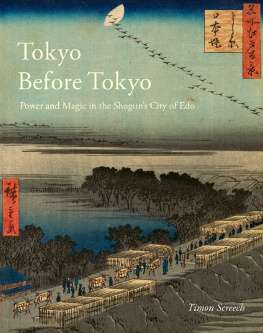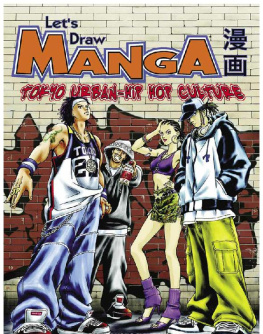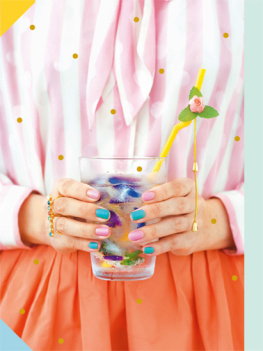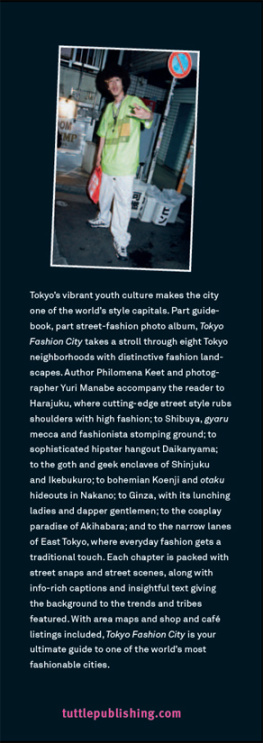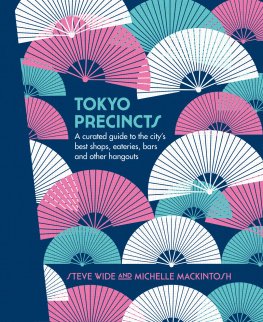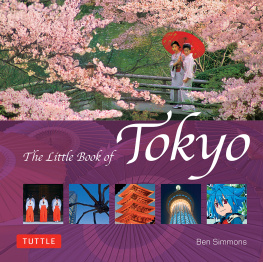
Contents
Chapter 1
What Is Tokyo Street Style?
Q&A
Shoichi Aoki
Editor in chief, STREET magazine
Chapter 2
Tokyos Street-Fashion Leaders
Q&A
Scott Schuman
Photographer, founder of The Sartorialist
Chapter 3
Vintage Finds
Q&A
Ebony Bizys
Founder of Hello Sandwich
Chapter 4
Tokyos Infinite Kawaii
Q&A
Olympia Le-Tan
Designer
Chapter 5
Genderless Style
Chapter 6
Fashionable Lifestyle, Tokyo Style: Concept Stores
Chapter 7
Fashion, Food, and More: A Tokyo Guide
Q&A
Takuya Ebe
Editor in chief of dancyu web

Tokyo Skytree rises (2,080 ft) 634 m above the city from its base in East Tokyo near the Sumida River. East Tokyo is a vibrant shopping area.

Traffic stops entirely and pedestrians surge into the intersection from all sides at Tokyos famous scramble crossing in Shibuya, a vibrant shopping area known for its large department stores.
Introduction
If you look at the streets in Tokyo, you will instantly get a sense of Japanese fashion trends.
Yoshiyo Abe, designer, Petite Robe Noire
Tokyo has been a major source of high fashion for decades, and the citys presence on the world fashion stage seems to be more prominent each year. Following in the footsteps of Japanese fashion icons, such as Rei Kawakubo at Comme des Garons, Yohji Yamamoto, Issey Miyake, Junya Watanabe, Jun Takahashi, Chitose Abe, and Hiromichi Ochiai, new, up-and-coming Japanese designers continue to gain recognition both from the fashion establishment and among their devoted fans from around the world.
While you can catch a glimpse of Mount Fuji from the upper floors of tall buildings throughout the city, its nearly impossible to see the end of the urban sprawl that radiates from the shores of Tokyo Bay all the way to the outer suburbs and beyond. Walking through the streets here and watching people go by, it seems that the possibilities for individual style are equally infinite. Despite Tokyos large scale, however, the streets and neighborhoods retain individual character, with style to match.
Experiencing Tokyo can be overwhelming for first-time visitors, but those who spend time here cant help but feel inspired by the creative dynamism and open, carefree approach to style on show amid the vibrant energy of the citythe endless landscape of tall buildings, flashing neon lights, and packed pedestrian crossings. Because people tend to observe traffic lights, there is a delicious anticipation just before the lights change and everyone moves together. There is also the surprising sight of hundreds of people boarding the crowded trains during the morning rush hoursometimes forcibly crammed into the cars by gloved attendants. Observing so many people just going about their daily lives, visitors to Tokyo often remark on how great everyone looks, how well-dressed, stylish, and put together they seem, whether its in a suit or uniform for work, a school uniform, or a simple outfit for running errands. Whats sometimes even more surprising is the range of styles that can be seen on any given street corner.
People in Tokyo have a particularly strong desire to be fashionable.
Shoichi Aoki, editor in chief, STREET magazine
Youll never get bored looking at the streets of Tokyo. Its a perfect city for people watching.
Naho Okamoto, founder and designer, SIRI SIRI
Your guides through this complex style mecca are two Tokyoites who have built successful careers in the fashion industry. Our author, Yoko Yagi, is a freelance fashion editor, writer, and a graduate of Tokyos renowned Bunka Fashion College, who has worked as a fashion editor for the magazine Soen (Bunka Publishing), which has been showcasing Japans most stylish women for more than eighty years. Through her work as a freelance fashion writer, fashion consultant, and marketing director, companies routinely seek Yagis advice on brand development. Our photographer, Tohru Yuasa, also a graduate of Bunka Fashion College, majored in styling for his degree before pursuing photography as a career after graduation. Yuasas sense of craft (he shoots using increasingly hard-to-find film in his spare time) and stylists eye for fashion and composition are evident in the shots youll see throughout the book.
What is important in fashion is whether you can be yourself or not.
Mariko Hayashi, designer, jonnlynx
Our goal is to showcase a range of individual styles through photographs and interviews with Japanese fashion designers, editors, artists, photographers, and fashion influencers. Each of the individuals featured possess an instinct for original style and an independent, bold approach to fashion that allows them to wear the clothes that help them express their points of view.
In the pages that follow, well hear from stylish individuals and learn what makes their approach unique and what their thoughts are on Tokyo fashion in general. Well take you on a treasure hunt through some of Tokyos best vintage stores, and hope youll be inspired by the ways in which Tokyos most stylish people incorporate vintage into their own looks. Well also explore the often misunderstood style concept of kawaii (which means pretty, adorable, or cute) by talking to fashion designers, shop owners, and other influential personalities who elevate Japans renowned cute culture to a more witty and sophisticated level. Their stores and clothes might seem soft and girly on the outside, but their razor-sharp take on kawaii has had a major influence on Tokyo street fashion and the designers and fashion labels defining Japanese style today.
Well move from superfeminine florals and frills to more androgynous, boundary-pushing looks, which Japanese designers have been producing for a generation and the rest of the world seems to be only just waking up to. Its fairly common for women to wear mens clothing and be called stylish, and Japanese designers like Yohji Yamamoto and Rei Kawakubo at Comme des Garons (which, of course, literally translates to like the boys) have been pioneering genderless styles for more than forty years. But the ways that the designers, fashion brands, boutiques, and other influencers of street fashion featured in this book conceive of gender and gender-free clothing these days are truly revolutionary and are sure to play an important role in the years to come, as gender-free styles become more central to global fashion movements.

Akane Sasaki, fashion publicist (left) and Hitomi Nomura, director, and buyer, Marte (right), both have devoted followings on social media attracting the young women who are regulars at the vintage shop Marte and who are interested in street fashion in Tokyo, due to their individual charisma and distinctive personal style.
Next page

